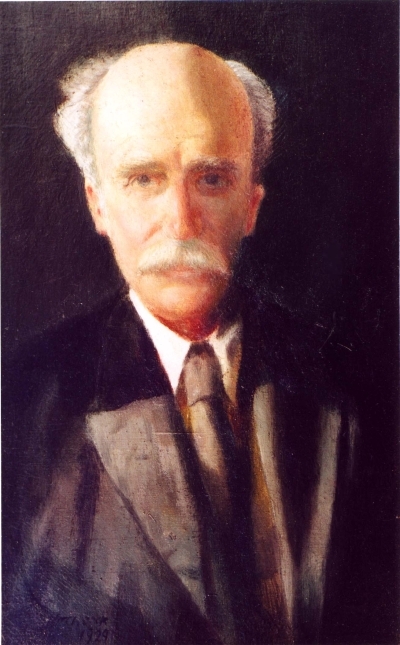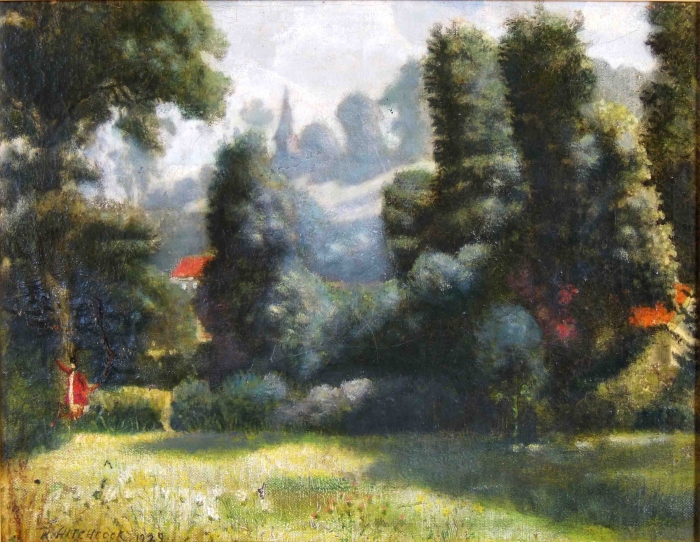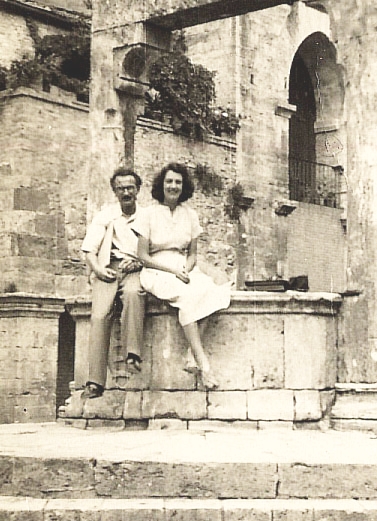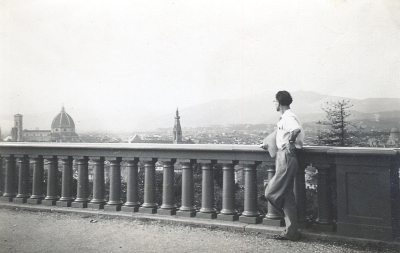| Born in 1914 in Camden Town, London, into a family of artists and musicians, Harold was always immersed in his inner world and used to keep his younger brother and sister entertained at an early age with his fantastical storytelling and subsequent writing. Both his mother and grandmother (who were descended from the animal artist George Stubbs) were gifted pianists and his maternal uncles were professional musicians and artists. His paternal grandfather was a woodcarver and restorer (and successful businessman!). |
| At the age of nine Harold went to live with his maternal grandparents; Fanny (nee Stubbs) who was a pianist (and natural psychic) and Arthur (Davis), who had worked as a schoolteacher in London's East End. They had retired to the Essex village of Thundersley where the young Harold visited them and begged to be allow to stay rather than return to London. It was here that his destiny as an artist unfolded and he started to paint having had an ecstatic experience in the grounds of their house. He was very close to his grandfather who encouraged Harold in his talent and shortly before he died asked the 15 year old to paint his portrait. The other painting that has survived from this period is an oil and the figure of Harold's sister Iris can just be made out on the left in red. |  'Grandfather Portrait' 1929. 'Grandfather Portrait' 1929. |
|
|
| Thundersley at that time was a paradise for the sensitive child and a world away from London - there was no electricity, mains water, or made-up roads and the doctor used to make his rounds in a pony and trap. It provided a nurturing environment for the young artist who reluctantly returned to London at the age of 16 after his beloved grandfather died |
 |
At around this time Dame Laura Knight was contacted about Harold's painting and she came to see some of his work and in particular a very large painting which he had executed on a mirror. She was amazed at what she saw and declared him a child prodigy. An article about Harold appeared at this time in the Daily Express to this effect, Dame Laura Knight at that time was a very well-known artist. Harold continued to paint and for a few years lived with his parents who had retired to Norfolk where they lived in a remote location in the salt marshes near to Great Yarmouth (an area known as 'Little Holland' due to the dykes and windmills used to drain the marshes). |
| Just before the outbreak of war Harold moved to Camden Town and started to work as a commercial artist for Universal publicity doing lithographic silkscreen posters. As a pacifist he became a conscientious objector and enlisted in the non-combatant corps. In 1940 he volunteered for bomb disposal because he felt he wasn't being useful enough and this work gave him a certain freedom which he would not have had otherwise. |  |
| Whilst still working in bomb disposal, around 1943, Harold developed the first symptoms of Trigeminal Neuralgia, a cripplingly painful condition associated with stress, which affected him for many years until he was operated on in the early 60s (a dangerous operation which could have left him blind but which was a great success). |
|
|
|
| Towards the end of the war, whilst he was billeted at Lancaster Castle, Harold met the great love of his life, Rose (then Joan). They met at a dance but did not maintain any contact but met again purely by chance a year later in Finchley, London. They married just after the war. Here pictured above, on honeymoon in Italy. They later went on the have three children and were virtually inseparable until Rose's death in 2004. Rose's portrait can be seen in very many of Harold's paintings, she was his muse and helper throughout her life. This painting below was the first to be done just after Rose's death. |
|
|
| In 1945 Harold was introduced to Dr. Alfred Torrie, who was a Brigadier and head of psychiatry for the army and his wife Margaret. They were very involved in the London art scene and held exhibitions at their large London house in Primrose Hill. They were very taken with Harold's work, (by then Harold had amassed quite a collection of watercolours) and gave him his first one-man show. This was attended by many top figures in the London art scene including the poet Walter De La Mare who loved Harold's work. Years later the Torries were to introduce Harold and Rose to Subud, a spiritual movement originating from Indonesia - in which they were involved. This was to have a profound influence on Harold's work. In 1962 Harold adopted his present name (he was formerly known as Raymond). |
| After the war Harold resumed doing commercial art work for the firm More O'Ferrall. In those days all the large advertising hoardings were hand-painted and Harold comments of this period that he was painting giant soup cans years before Andy Warhol! It is a testament to Harold's inner drive and dedication to his art that he was able to work all week on those giant billboards and then work on his own paintings at the weekend. Now living in Hampstead, Harold exhibited his work at the Hampstead outdoor exhibition at Whitestone Pond every summer where he sold everything he showed. |
| In 1964 Harold was given the opportunity by a friend (Monty Franks) to give up the commercial work he had been doing for so many years and concentrate full-time on his own painting. Monty was prepared to fund Harold for a year and took on the task of promoting his work. This wasn't such an easy decision for Harold, who had a young family to support but he took the plunge and never looked back! His creativity flourished as did the market for his work with major London exhibitions followed by successful shows in the USA that subsequently became the main market for his work. Early on Harold benefited from the patronage of the then Duke of Bedford (who was quite a media celebrity at the time) who had seen some of Harold's work in the shop of his bespoke shirt maker (a client of Monty's!). He was so enthused by the work that he decided to give Harold a show at Woburn Abbey, his palatial residence, and then toured the States with Harold promoting his work through several exhibitions and TV appearances. |
|
|
| Since that time Harold continued to enjoy much success in the States and elsewhere, painting with a freedom, depth of vision and confidence in his craft that was astonishing to his admirers. In August 2009 he died peacefully at his home five weeks after completing his last painting at the age of 95 leaving behind an astonishing body of work virtually unparalleled in its variety and originality. |
|
|

 'Thundersley' 1929.
'Thundersley' 1929.

 'Sacred Grove' 2004.
'Sacred Grove' 2004.
